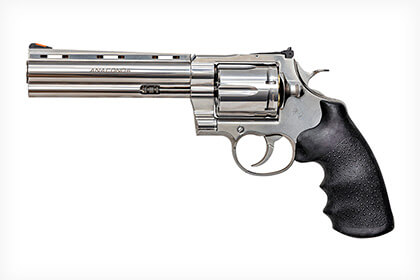
For the benefit of those who are not familiar with Colt’s Anaconda, it is the big-bore member of the company’s family of “snake” revolvers and was originally produced from 1990 to 1999. To touch on a bit more history, the first of Colt’s deadly serpents to emerge was the Cobra in .38 Special in 1950, and it remained in production for 31 years. It was followed by the Python in .357 Magnum (1955 to 2005). Next came the Diamondback in .38 Special (1966 to 1988). Rarest are the Viper in .38 Special, built during 1977 only, and the Boa in .357 Magnum made during 1985.
Leaping forward to 2017, Colt introduced a redesigned version of the Cobra, followed by the King Cobra in 2019 and the Python in 2020. The Anaconda is the big news for 2021, and like all handguns now produced by Colt, it is built at the historic Hartford, Connecticut, factory. Today’s Anaconda is basically an upsized version of the new Python, and internally, it has nothing in common with the old revolver of the same name.
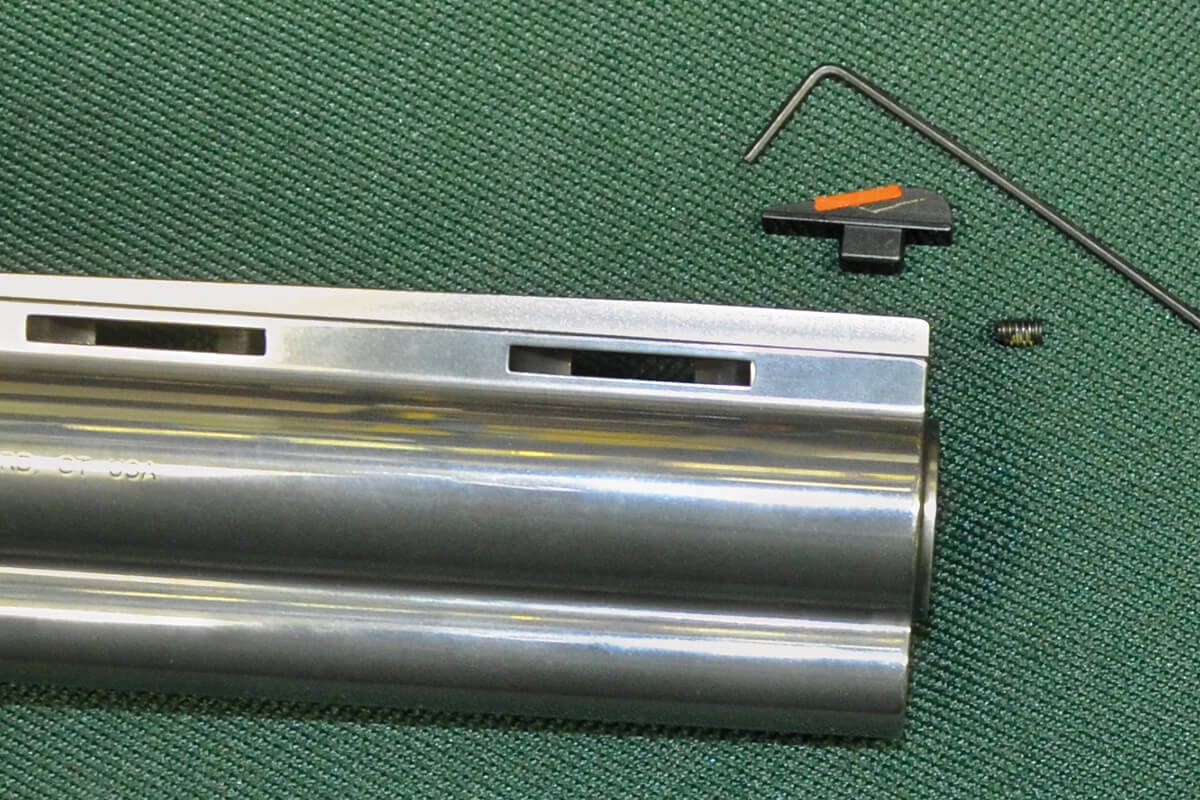
A Real Handful
Built on Colt’s MM-size frame, the Anaconda is a handful, but its 59.4-ounce weight (for the 8.0-inch-barreled model) does a good job of dampening .44 Magnum recoil. Open sights consist of a fully adjustable leaf with a 0.130-inch notch at the rear and a 0.130-inch-wide ramped blade with red insert up front. Switching out the front sight for another style is as easy as turning out a small retention screw at the front of the barrel rib.
Barrel length options are 6.0 and 8.0 inches, and my test gun had the 8.0-inch barrel. From 0.835 inch in diameter at the receiver, the barrel tapers to 0.825 inch at the muzzle, where it has a recessed crown. The barrel is fairly heavy, and the added weights of a ventilated rib along with a full-length underlug minimize muzzle rise when firing heavy loads. My Lyman Digital Borecam revealed extremely smooth six-groove, left-hand rifling. The twist rate is 1:20.
The topstrap of the frame is drilled and tapped for mounting a Picatinny rail available from Colt. Two holes are in permanent view, and a third is exposed when the rear sight is removed. Detaching the sight is easy. Using a small screwdriver, remove the elevation screw and its spring, push out the horizontal pin with a 2.5mm punch, and the job is done. When switching back to the open sight, use a small plastic mallet to gently drive the pin back into position.
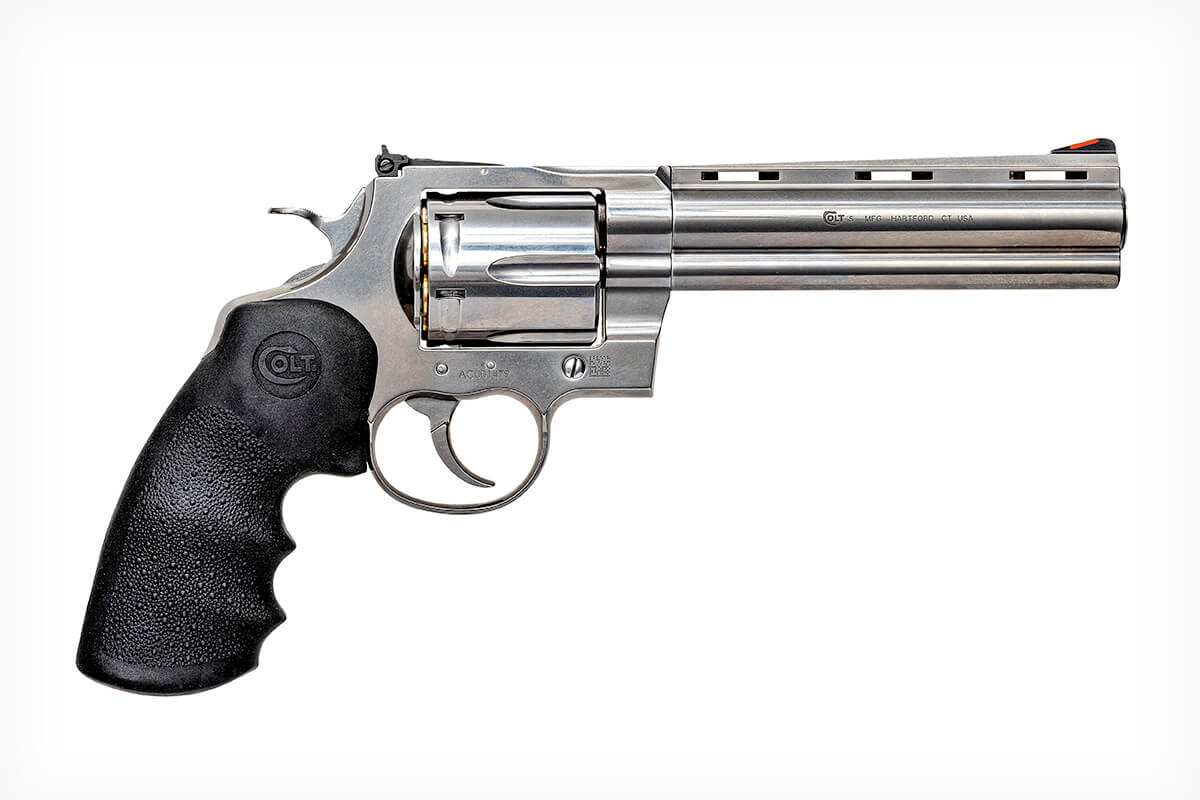
The optic rail is held in place by the three screws, while the recoil load is handled by contact of a thick integral shoulder at the bottom of the rail with a vertical flat machined into the frame for rear-sight clearance. When accuracy testing the Anaconda at 100 yards from an MTM K-Zone handgun rest, I used a Nikon Force XR 2.5-8X handgun scope attached to the rail with three rings from Weigand Combat Handguns. That put fully loaded weight at 5.0 pounds. Loctite 248 applied to the threads of all screws was allowed to dry for a week prior to the gun being shot. Close to 200 rounds of full-power rounds were fired, and the mounting system never loosened or budged.
As revolvers in .44 Magnum go, the six-round cylinder of the Anaconda is uncommonly long at 1.905 inches for a considerable increase in chamber length. In comparison, the cylinders of the Ruger Super Redhawk and Smith & Wesson Model 29 are 1.750 inches long. The cylinder of the Model 29 is recessed for cartridge rims, and that puts actual chamber length a bit shorter than for the Super Redhawk. Whether or not any of this really matters is dependent on the overall cartridge length desired. SAAMI maximum for the .44 Magnum is 1.610 inches, and since factory ammo as well as most handloads listed in various reloading manuals are held within that, it matters not to most shooters.
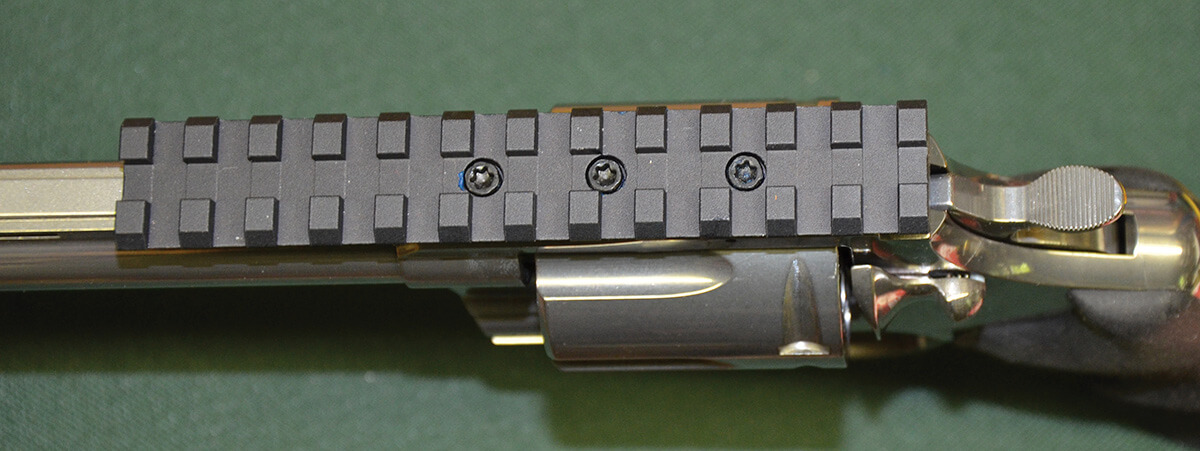
On the other hand, longer chambers become more important when ammo loaded with uncommonly heavy cast bullets is used. Examples in the .44 Magnum section of Hodgdon’s Annual Manual are cartridge lengths of 1.710 inches for a 355-grain cast bullet and 1.730 inches for those weighing 325 and 330 grains. The Rim Rock 335-grain bullet I shot in the Anaconda was loaded to a cartridge length of 1.730 inches.
With those cartridges in the chambers of the three guns, the distance from bullet nose to front of cylinder is 0.234 inch for the Anaconda, 0.022 inch for the Model 29, and 0.077 inch for the Super Redhawk. While the three loads will fire in those guns, should recoil cause a bullet to jump its roll crimp and creep forward, it will have much farther to travel in the Anaconda before blocking cylinder rotation.
I hasten to add that lighter bullets are capable of handling most of the game taken by most handgun hunters, but when an enraged bear is headed your way and no other option remains, the increased penetration and huge energy delivery of a long, heavy, hard-cast bullet is good to have. And for those who believe increasing free-travel of lighter bullets from case to barrel engagement harms the accuracy of a revolver, I will point out that when fired from the Anaconda, the handload carrying the stubby Hornady 240-grain XTP averaged just 3.14 inches at 100 yards.
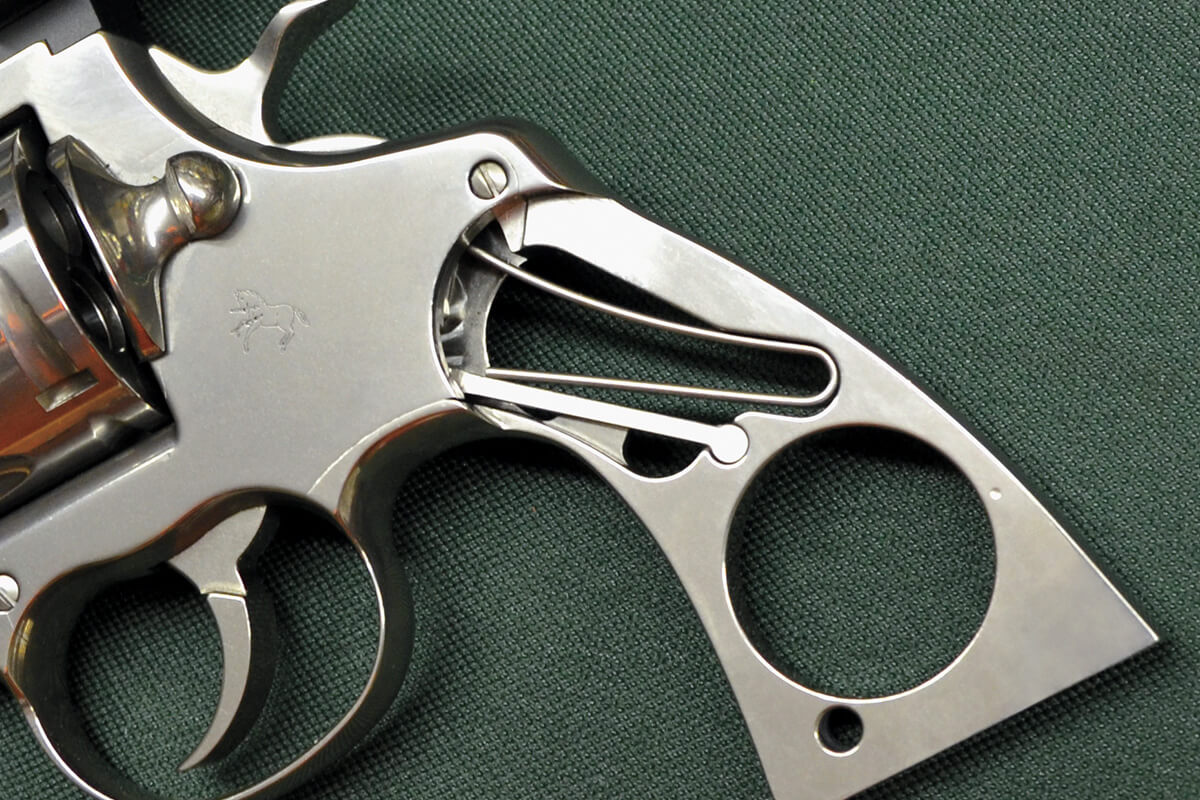
Uniform, Consistent, Accurate
With diameters ranging from 0.4310 inch to 0.4314 inch, the new Anaconda’s chamber throats were quite uniform. Cylinder gap at lockup was a snug 0.005 inch. The cylinder had slight amounts of rotational looseness and endshake, but considering the impressive accuracy of the gun, neither was enough to matter. Chamber wall thickness is 0.120 inch.
An extractor star travel of 0.970 inch proved to be plenty long for sending spent .44 Magnum cases flying from heavily fouled chambers.
The transfer bar safety system of the Anaconda requires a frame-mounted firing pin. The gun also has what is described by Colt as an LL2 Linear Leaf Trigger System. Said another way, its mainspring is the leaf-type rather than the coil-type. The single-action pull was quite smooth with no creep and only a trace of overtravel, but its average weight on my Lyman digital scale was a bit heavy at 5.75 pounds.
The double-action trigger pull was a happier story, as it was plenty smooth and light enough for accurate rapid-fire shooting. On a rapidly incoming grizzly (which looked a lot like paper plates stapled to wooden stakes at five, 15, and 25 yards), I began with a two-handed hold, raised the Anaconda (wearing its factory open sights), and rapid-fired two rounds at each target, beginning at 25 yards and ending at five yards.
This was repeated five times using handloads with the Rim Rock 335-grain bullet, and average elapsed time for the runs was 5.4 seconds. The 10-shot group at 25 yards measured just over 5.0 inches, and due to closer distances, groups on the other plates were considerably smaller. Counting my first-shot reaction time, a real grizzly charging from 50 yards would have been on me after only two, maybe three shots, so the deadliest blow possible from each bullet would be important. Common sense tells us that uncommonly heavy bullets deliver the goods.
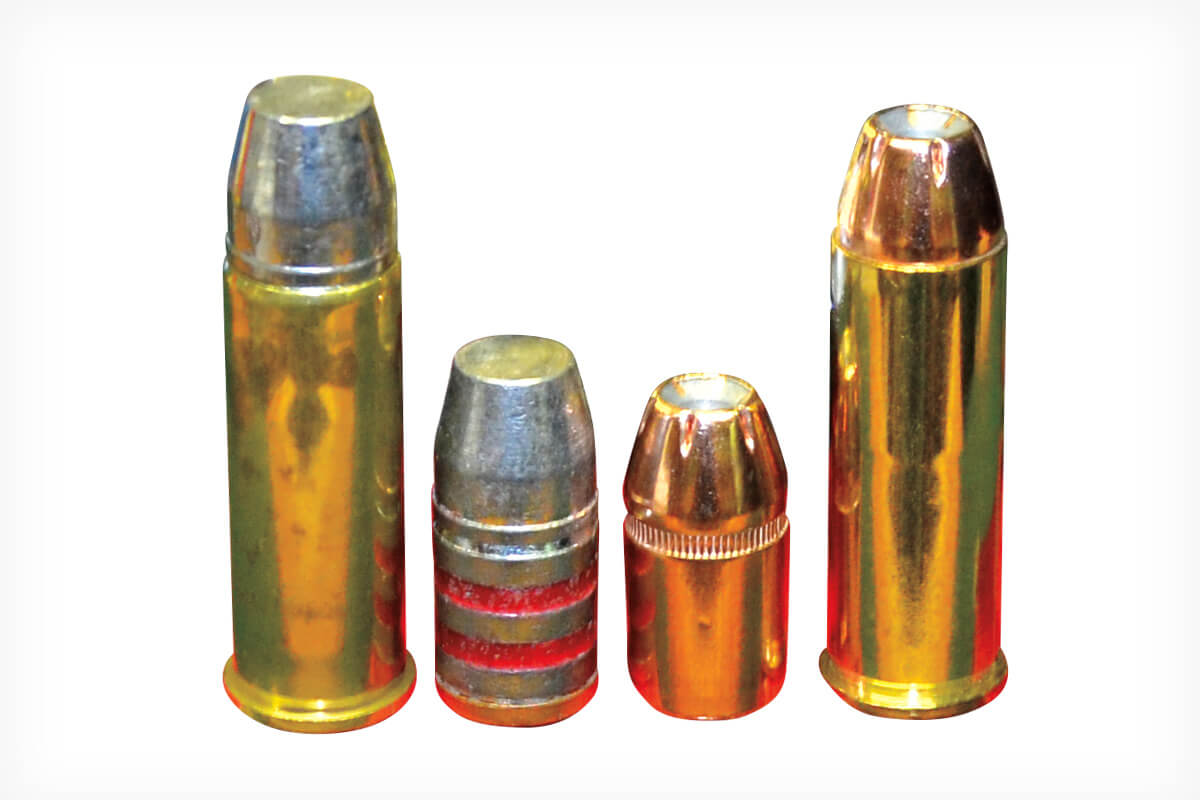
A clockwise-revolving cylinder originated at Colt with percussion revolvers of the 1800s, and the Anaconda follows that tradition. Cylinder rotation is just the opposite for most other revolvers of American design, including those made by Smith & Wesson. Another obvious difference is in their cylinder latches. To swing out the cylinder, you pull on the Colt latch and push on the S&W latch. Through the years, I have shot many more S&Ws than Colts, yet when shooting the Anaconda, pulling rather than pushing presented no problem. But then, I shoot quail in the morning with a side-by-side shotgun with a single trigger and switch to one with two triggers for the afternoon hunt without giving the difference a single thought.
The original Anaconda had checkered wooden grip panels, but the new version has a Hogue one-piece rubber grip with finger grooves. As is often the case these days, the new is not as pretty as the old, but it does make the gun more comfortable to shoot. The trigger guard is plenty roomy for shooting with gloves during cold weather.
Today’s 8.0-inch-barreled Anaconda is an excellent choice for hunting (see “Galco Kodiak and Kodiak Hunter Shoulder Holsters” for more on my carry rig), but I would opt for the slightly more compact 6.0-inch barrel for camping, hiking, and fishing in bear country. The original was available with a 4.0-inch barrel, and while it would likely sell quite well today, there’s no official word from Colt on that. The same goes for an Anaconda in .45 Colt.
Anaconda Specifications
- Manufacturer: Colt’s Mfg. Co. LLC, colt.com
- Type: Double-action revolver
- Caliber: .44 Magnum/.44 Special
- Cylinder Capacity: 6 rounds
- Barrel: 6.0, 8.0 in. (as tested)
- Overall Length: 15.0 in. (8.0-in. barrel)
- Width: 1.76 in.
- Height: 6.75 in.
- Weight, Empty: 59.4 oz. (8.0-in. barrel)
- Grips: Hogue rubber
- Finish: Semi-bright stainless steel
- Sights: Fully adjustable rear, red ramp front
- Trigger: 5.75-lb. single-action pull (as tested)
- MSRP: $1,499


